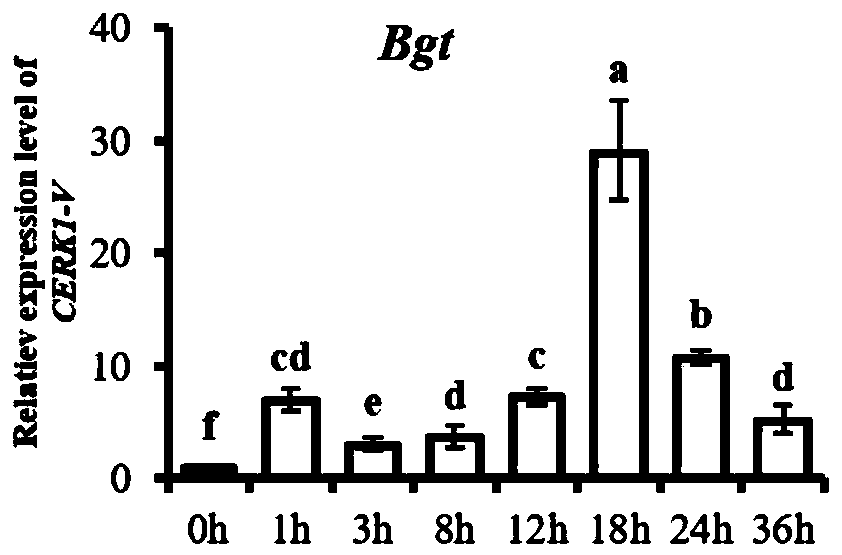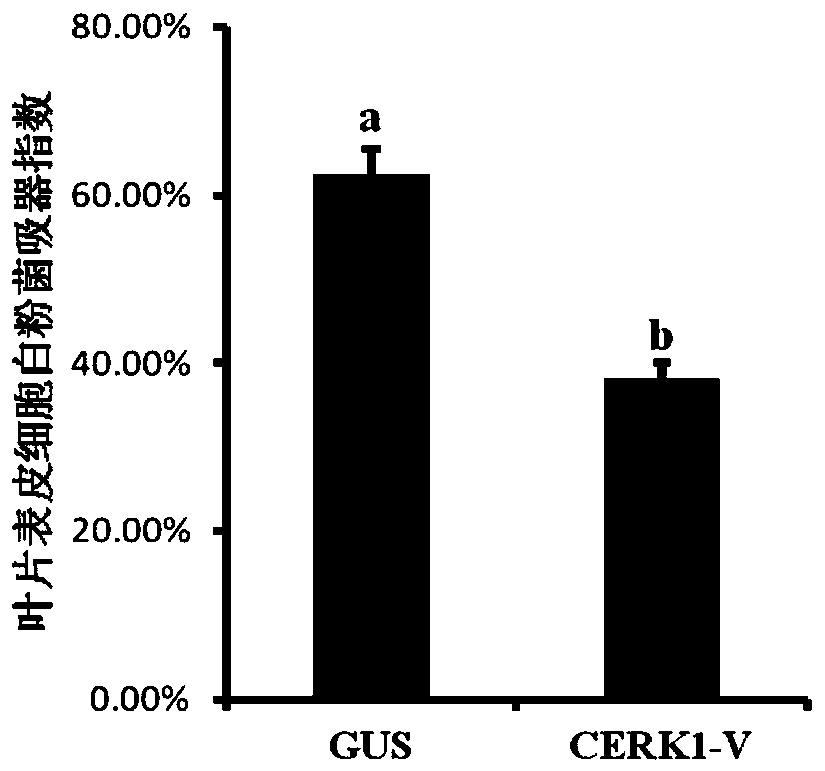Haynaldia villosa CERK1-V gene, and encoded protein and application thereof
A CERK1-V, villous wheat technology, applied in the field of genetic engineering, can solve the problems of increasing manpower, material resources, environmental pollution, etc.
- Summary
- Abstract
- Description
- Claims
- Application Information
AI Technical Summary
Problems solved by technology
Method used
Image
Examples
Embodiment 1
[0025] Example 1 Cloning of CERK1-V gene and expression characteristics induced by powdery mildew
[0026] Homologous cloning primers P1 (ATGGAAGCTCCGCTCCTC, SEQ ID NO.3) and P2 (TCATCTCCCGGACATG, SEQ ID NO.4) were designed to clone the 1866bp sequence in the cDNA induced by Erysiphe spp. Shown in NO.1. The sequence encodes 621 amino acids, the sequence is shown in SEQ ID NO.2, and the gene is named CERK1-V.
[0027] The powdery mildew resistant wheat seeds (references: Qi Lili, Chen Peidu, et al., New source of resistance to powdery mildew in wheat—gene Pm21, Acta Crops, 1995, 21(3):257-262) were sown in a petri dish to germinate , transplanted to pots after dew whitening (isolated with cylindrical transparent plastic sheets around, and closed with filter paper at the top to form an environment without powdery mildew). At the three-leaf stage, shake off the fresh spores of Nanjing local mixed powdery mildew cultured on the susceptible variety Sumai No. 3 on the seedlings of...
Embodiment 2
[0029] Example 2 Construction of CERK1-V gene overexpression vector silencing vector
[0030] Using the above-mentioned CERK1-V gene cloning vector pMD18T-CERK1-V, the primer pair P5 (CG GGATCC ATGGAAGCTCCGCTCCTC, SEQ ID NO.7) and P6 (GA AGGCCT TCTCCCGGACATGAGGTTC, SEQ ID NO.8) for PCR amplification, and recovered amplified fragments. Insert the amplified target fragment into the vector pBI220 by double digestion with BamHI and StuI (references: Jefferson RA, Kavanagh TA, Bevan MW. GUS fusions: beta-glucuronidase as a sensitive and versatile genefusion marker in higher plants. EMBO J.1987 , 6:3901-3907) between the multiple cloning site BamHI and StuI behind the 35S promoter. Thus, the CERK1-V gene overexpression vector pBI220-CERK1-V (attached figure 2 ).
Embodiment 3
[0031] Example 3 Using single cell transient expression technology to transfer CERK1-V gene overexpression vector into wheat leaves
[0032] Single-cell transient expression technology is a reliable and rapid method for identifying gene functions (reference: Schweizer, Pokorny et al. A Transient Assay System for the Functional Assessment of Defense-Related Genes in Wheat Molecular Plant-MicrobeInteractions.1999,12:647 -654). In this study, the single-cell transient expression method was used to wrap plasmid DNA on the outer layer of metal particles, and the metal particles were bombarded to the epidermal cells of wheat leaves with the help of a gene gun, and then the powdery mildew haustoria index of the bombarded GUS cells was counted to determine whether the target gene It has powdery mildew resistance function.
[0033] The procedure for encapsulating carrier DNA and metal particles is as follows:
[0034] Preparation of tungsten powder: Weigh 30mg of tungsten powder into...
PUM
 Login to View More
Login to View More Abstract
Description
Claims
Application Information
 Login to View More
Login to View More - Generate Ideas
- Intellectual Property
- Life Sciences
- Materials
- Tech Scout
- Unparalleled Data Quality
- Higher Quality Content
- 60% Fewer Hallucinations
Browse by: Latest US Patents, China's latest patents, Technical Efficacy Thesaurus, Application Domain, Technology Topic, Popular Technical Reports.
© 2025 PatSnap. All rights reserved.Legal|Privacy policy|Modern Slavery Act Transparency Statement|Sitemap|About US| Contact US: help@patsnap.com



